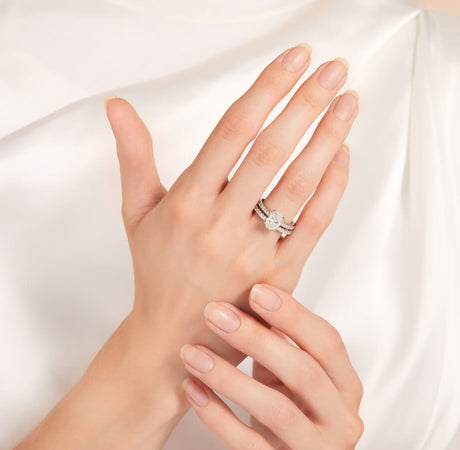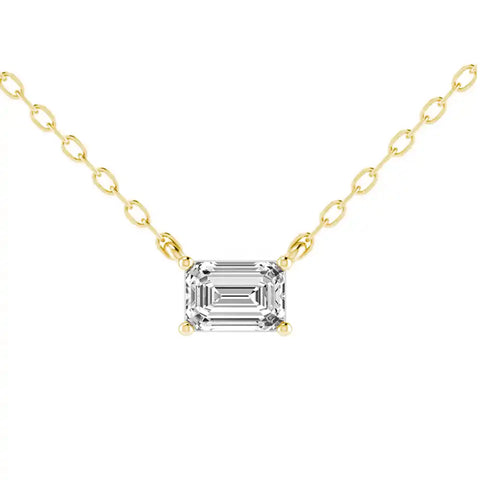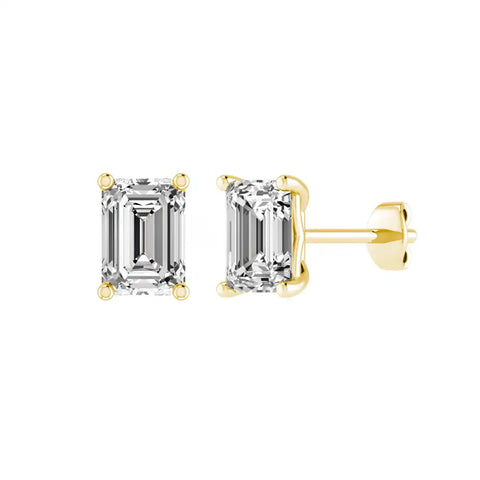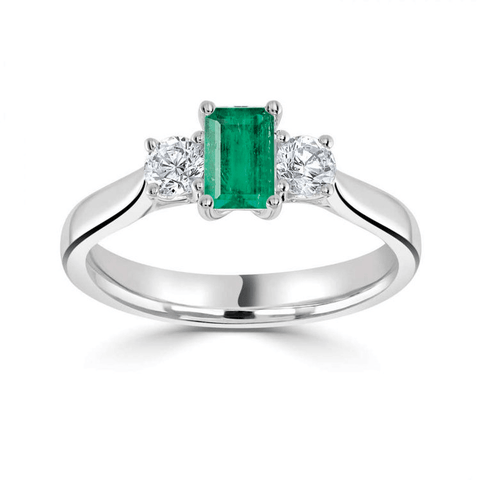From our GIA experts
Emerald Cut Guide
For those once-in-a-lifetime moments that call for pure sophistication, finding the perfect symbol of love becomes a reflection of personal style and enduring commitment. Emerald cut diamonds, with their clean lines and understated elegance, offer a sense of refined beauty that transcends time. Known for their mirror-like facets and graceful silhouette, they are a stunning choice for proposals, engagements, and lasting love stories. We’ve crafted this guide with care for those drawn to quiet luxury and timeless distinction—an emblem of love that’s as poised and unique as your journey together.
Trending now
Emerald Cut Jewellery
Emerald 4cs
Choosing an Emerald Diamond: Factors to Consider
When it comes to choosing a diamond that embodies timeless sophistication and modern grace, the emerald cut is a striking choice. With its sleek, rectangular shape and step-cut facets, it offers a refined, architectural beauty that sets it apart. This guide is designed to walk you through the essential features of emerald cut diamonds, helping you make a selection that reflects your style and the enduring meaning behind your moment.
The Best Ratio for an Emerald Cut Diamond
The length-to-width ratio significantly influences the overall appearance of an emerald cut diamond. A ratio between 1.30 and 1.50 is considered ideal—lower ratios yield a more square-shaped stone, while higher ratios result in a longer, slimmer profile. Your preference may depend on hand shape, ring design, or whether you’re seeking a bold, geometric look or a more balanced, classic aesthetic.
Emerald Cut Guide: Understanding Cut Quality
Unlike round brilliant diamonds, emerald cuts don’t rely on sparkle to impress—instead, they emphasize clarity, symmetry, and precision. Their step-cut facets create a “hall of mirrors” effect, offering understated flashes of light. Because of their open table and geometric lines, cut quality is crucial: look for excellent polish, symmetry, and proper depth to ensure crisp reflections and clean lines throughout the stone.
Emerald Colour Guide
Emerald cut diamonds tend to show more visible color than brilliant cuts due to their large, open facets. For a cooler, more colorless look—especially in white gold or platinum settings—choose a color grade of G or higher. If set in yellow or rose gold, H to J grades can still appear beautiful and warm, depending on personal taste.
Emerald Clarity Guide
Because of the emerald cut’s transparent nature and lack of brilliant-style facets to mask flaws, clarity is especially important. Inclusions that might be hidden in other cuts can be easily visible here. For best results, opt for VS2 or higher clarity. However, well-placed inclusions in SI1 diamonds may still be acceptable if they are not visible to the naked eye.

How to choose an emerald diamond
Buying Guide
The emerald cut is a step cut, known for its clean lines, long rectangular facets, and elegant symmetry. Unlike brilliant cuts that focus on sparkle, the emerald cut emphasizes clarity and sophistication, offering a “hall of mirrors” effect through its broad, open facets. As a member of the fancy cut family, it provides a refined alternative to classic round shapes—perfect for those drawn to understated luxury and timeless geometry. Its elongated silhouette flatters the finger, while its minimalism makes it a favourite for those seeking a modern yet enduringly classic look.
-
Length-to-Width Ratio:
Emerald cut diamonds are typically rectangular, with ideal length-to-width ratios ranging from 1.30 to 1.50. A lower ratio will give a more square appearance, while a higher ratio creates a longer, more slender silhouette. The best ratio depends on personal style and how the shape complements the wearer’s hand.
Facets:
Emerald cuts feature step-cut facets, usually with 57 facets arranged in parallel lines. This facet structure produces a sleek, mirror-like effect rather than intense sparkle, emphasizing clarity and symmetry over brilliance.
Light Performance:
Rather than fiery brilliance, emerald cut diamonds offer a refined “hall of mirrors” effect—broad flashes of light that move across the stone. Because of the large, open table and linear facets, light performance depends heavily on the precision of the cut.
Inclusion Visibility:
Due to the open, transparent nature of the emerald cut, inclusions and flaws are more visible than in brilliant cuts. For this reason, clarity becomes especially important—opt for VS2 or higher, or ensure that any inclusions are well-placed and not visible to the naked eye.
-
Cut Quality:
Emerald cuts rely heavily on precision and symmetry to achieve their signature “hall of mirrors” effect. Since they don’t sparkle like brilliant cuts, look for excellent polish, symmetry, and proper proportions—especially table and depth percentages—to ensure crisp reflections and minimal windowing or darkness within the stone.
Colour and Clarity:
The open, step-cut facets of emerald cuts make both colour and inclusions more visible, so quality matters. Aim for a colour grade of G or higher for a bright, colourless appearance—especially in platinum or white gold settings. For clarity, VS2 or better is recommended, though an eye-clean SI1 may still offer great value if inclusions are well-positioned.
Settings:
Emerald cut diamonds look striking in solitaire, three-stone, and bezel settings, where their clean lines and elongated shape can shine. East-west settings offer a modern twist, while halo or vintage-style settings can add extra glamour. A four-prong or double-claw setting helps protect the sharp corners without interrupting the elegant profile.
-
Solitaire:
A solitaire setting showcases the emerald cut’s crisp lines and geometric elegance. This minimalist style lets the diamond take center stage, highlighting its length, clarity, and classic appeal—perfect for those drawn to timeless simplicity.
Halo:
A halo of smaller diamonds adds brilliance and visual impact to the emerald cut’s understated sparkle. This setting enhances the size and presence of the center stone while providing a glamorous, eye-catching frame that contrasts beautifully with the emerald’s clean silhouette.
Vintage-Inspired:
Emerald cuts pair beautifully with vintage-inspired settings featuring details like milgrain, filigree, or tapered side stones. These styles nod to the Art Deco era, emphasizing the emerald cut’s architectural lines and refined charm.
Bezel Setting:
For a sleek, modern aesthetic, a bezel setting wraps the emerald cut in a smooth metal rim. This design enhances durability—especially at the corners—and provides a bold, contemporary finish that’s both stylish and secure.
Three-Stone:
Flanking the emerald cut with side stones, such as trapezoids, baguettes, or smaller emeralds, adds dimension and meaning. Often symbolizing the past, present, and future, this setting style offers a balanced, elegant profile that suits both traditional and modern tastes.

Timeless Precision
History of Emerald Cut
The emerald cut diamond traces its origins back to the 15th century, originally developed for emerald gemstones to prevent breakage during the cutting process. Its clean lines and step-cut facets soon found their way into diamond cutting, prized for their ability to highlight a stone’s clarity and symmetry. Popularized during the Art Deco era of the 1920s for its sleek, geometric appeal, the emerald cut became a symbol of elegance and modern sophistication. While the cut has evolved with precision over time, it continues to embody a timeless sense of refinement that remains a favorite among those with a taste for understated luxury.
Ring Styles & Inspiration
Grace Kelly’s engagement ring from Prince Rainier III of Monaco is one of the most iconic emerald-cut diamonds in history. The 10.48-carat stone, flanked by two baguette side stones and set in platinum, perfectly captured her timeless elegance and royal poise—an enduring symbol of classic Hollywood glamour turned royalty.
Elizabeth Taylor famously wore an emerald-cut diamond engagement ring gifted by Richard Burton. Weighing an astonishing 33.19 carats, the diamond became a global icon of luxury and passion, emblematic of their legendary love affair.


frequently asked questions
Unsure about anything? Find our frequently asked questions.
Can't find the answers your looking for? Our team is on hand from Monday to Friday, 10am - 5pm.
-
Yes—emerald cut diamonds are a timeless, elegant choice. Their clean lines, symmetrical facets, and elongated silhouette offer a refined alternative to brilliant cuts. They’re especially popular among those who value clarity and understated sophistication.
-
Not quite. Emerald cuts are step-cut, meaning they produce a "hall of mirrors" effect—broad flashes of light rather than intense sparkle. While they may not offer the same brilliance as round cuts, their shine is more subtle and sophisticated.
-
Because emerald cuts have large, open facets, inclusions are more visible than in other shapes. For the best appearance, look for VS2 clarity or higher, or choose an SI1 stone that is eye-clean and well-positioned.
-
Emerald cuts are considered timeless, but they’ve also enjoyed a resurgence in modern engagement ring trends. Their vintage appeal, paired with a minimalist, architectural shape, makes them a go-to for those who want a ring that feels both classic and current.
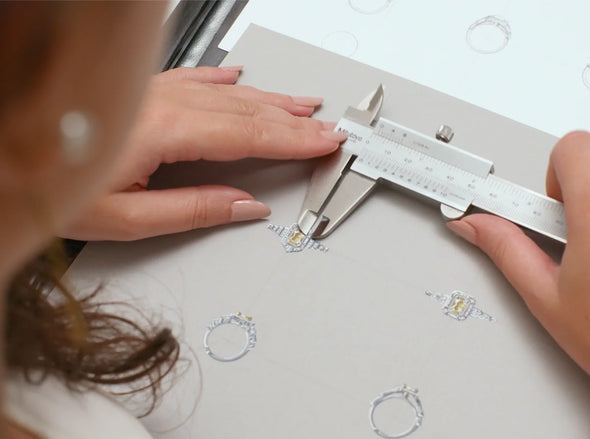
Bespoke Services
Design your own bespoke engagement rings and transform ideas into reality.
We specialise in made-to-order diamond engagement rings. Whether you recreate one of our classic designs or have an idea of your own.
